Minesweeper
Welcome to Minesweeper, one of the most popular singleplayer logic video games! This is an online version that is available to everyone for free. Enjoy!
This Minesweeper online game was created in 2021 and is a modification of the game written by Shep Poor and distributed under Creative Commons license. Original Minesweeper game © 1981-1995 Microsoft Corp.
Overview
Minesweeper is a logic puzzle that consists of a board of squares. Initially, every square is covered, and the player does not know what is hidden beneath the cover. In the initial move, the player has to click anywhere on the board. This will uncover the square that the player clicked, as well as some of the surrounding squares. Some of the squares will have numbers in them. A number indicates how many mines are in the surrounding squares. The goal is to use these numbers to infer where the mines are. If you figure out the location of a mine, you can then flag it by clicking on it with the right mouse button. As you flag mines, you will also deduce that some squares cannot contain mines. You can safely uncover them using the left mouse button.
Copyright © 2021-2025 simiade.com. All rights reserved.
Terms and Conditions | Privacy Policy
Instructions and rules
Here are some hints that may be helpful:
- You can click on the yellow smiley (or occasionally sad) face to restart the game.
- You can zoom in and zoom out of the game using the Options menu.
- If you left-click on a square with a number, and the squares around it already have the same number of flags as the number you just clicked, then the other remaining adjacent covered squares will be revealed. This feature is called Safe Neighborhood.
- The objective of the game is to uncover all the fields that do not contain mines. You don’t have to plant flags at all!
Here is how the options that are available in this game work:
- Safe Start – when you make an initial click with this option enabled, you will always find a square that is empty, so that you discover a large area. With this option turned off, the board is created entirely randomly, so with your first click you can find a single digit, or even a mine!
- Question marks – with this option turned on, after you right-click on the flag, you will change it into a question mark. Click once more to remove the question mark. If this option is off, then right-clicking will only plant a flag or remove it.
- Safe Neighborhood – with this option enabled, you can click on a digit which has the corresponding number of mines flagged around it in order to uncover the remaining surrounding squares. If this option is switched off, then clicking on a digit will do nothing.
- Open Remaining – with this option on, after finding all the mines and marking them with flags, once the digital display with the number of remaining mines shows "000", you can then click on this display to uncover all remaining squares.
- Disarm – when this option is enabled and you click on a mine, you will have three seconds to save yourself. If the option is off, you simply die immediately.
- Hint – with this option turned on, you can hover your mouse over a square and press H to reveal what is hidden underneath.
How to play Minesweeper: solving example
This little tutorial will show you how to solve a game of Minesweeper.
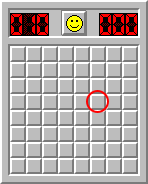 | In this example, we start with a Beginner difficulty level. The number of remaining mines is shown on the digital display in the top-left corner of the Minesweeper board. It is saying “10”, which means that we have 10 mines to find. Let’s start by left-clicking on the randomly-selected square. In this example, we are going to choose the square marked with a red circle. |
 | After our initial click, a number of squares are uncovered. Some of the uncovered squares have numbers in them, and some of them are empty. The numbers indicate how many mines are hidden beneath the surrounding covered squares. Notice the square with a “1” in it, marked by a red circle. There is only one covered square adjacent to it (marked with a brown circle). And since there is only one adjacent mine, then the mine must be beneath this covered square. Let’s plant a flag on this square by right-clicking on it. |
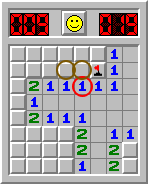 | Now that we have planted our first flag, we can begin to uncover more squares. Take a look at the square with the “1” in it, marked with the red circle. We know that there is only one mine in all three squares above it, but we have already found this mine and marked it with a flag. This means that in the two remaining squares (marked with brown circles), there is no mine. We can now safely uncover them by left-clicking on them. |
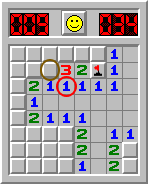 | Now we are ready to plant our second flag. As before, we can find a square with a “1” in it (marked with a red circle), which has only one covered square around it (marked with a brown circle). The mine must be there, and so we can safely plant a flag by right-clicking on this covered square. |
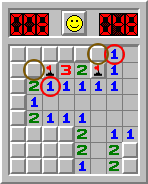 | After planting the second flag, we again notice squares with “1”s in them, which already have flags in their neighborhoods. Two of these squares are marked with red circles. Since both of them already have one flag nearby, then there cannot be a mine in the other covered squares located adjacent to them (marked with brown circles). We can left-click on these squares to uncover them. |
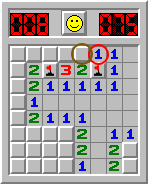 | Again, there is a square with a “1” in it, for which the adjacent mine has already been found. Let’s left-click on the only remaining covered square (marked with a brown circle). |
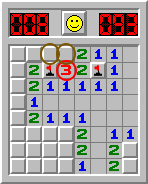 | Now let’s pay close attention to the “3” marked with a red circle. There are three mines in the adjacent squares, and there are three covered adjacent squares in total; one to the left has already been marked with a flag, and the remaining two above are still unmarked. There is no other way – the two covered squares must contain mines because there are three mines in the squares adjacent to the digit “3”. Let’s plant flags in these two squares. |
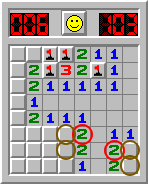 | Now let’s look at the two squares containing the digit “2”, marked with red circles. Both of these squares have only two adjacent covered squares, marked with brown circles. These two adjacent squares must therefore contain mines. Let’s plant our flags there. |
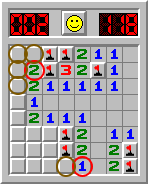 | Now we can identify some squares that already have the appropriate number of mines flagged around them. The two examples are marked with red circles. Since the number of mines in adjacent squares matches the digits, this means that the remaining covered squares cannot contain mines. Thus, we can uncover them by left-clicking on them. Let’s uncover all the squares marked with brown circles. |
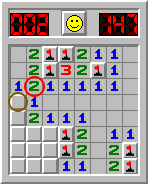 | One of the squares (marked with a red circle) contains the digit “2” and has only two covered squares around it, one of which is already marked with a flag. We can mark the other square with a flag, as well. Let’s right-click on the square with a brown circle. |
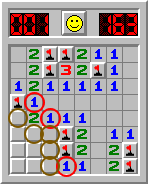 | In the next step, we see three squares with the digit “1”, all of which already have a mine in their vicinity. All other adjacent squares can then be safely uncovered. They are marked with brown circles. |
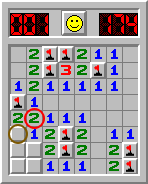 | Now let’s focus on the digit “2”, marked with a red circle. Like before, it has only two covered squares around it, one of which has been already flagged. We can therefore plant the flag in the other one (marked with a brown circle). Notice that as we do, our mine counter in the top-left part of the Minesweeper board indicates that the remaining number of mines drops from one to zero. This means that we can now safely uncover all remaining squares, as they surely do not hide mines underneath them – as all of the mines have already been found! |
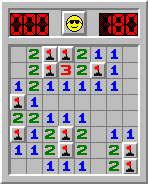 | We’ve won the game! The time counter in the top-right corner of the Minesweeper board indicates that it took us exactly three minutes to complete the game. |
History
Minesweeper is an old game of logic that was first designed over 50 years ago. It was popularized after being included in Microsoft Windows 3.1 in efforts to help people learn how to use the computer mouse and teach them the usefulness of left-clicking and right-clicking.
The creators of Minesweeper, Robert Donner and Kurt Johnson, took inspiration from the 1985 Relentless Logic game, the old board game Battleship, as well as the computer game Hunt the Wumpus.
Minesweeper very quickly won the hearts of many players around the world, and is now on any list of the most played games of all time. Rumor has it that even Bill Gates himself once loved to play Minesweeper!
Languages
You can play this version of Minesweeper online in the following languages:
- العربية - كانسة الألغام
- Български - Миночистач
- Čeština - Hledání min
- Dansk - Minestryger
- Deutsch - Minesweeper
- Eesti - Miinijahtija
- Ελληνικά - Ναρκαλιευτής
- English - Minesweeper
- Español - Buscaminas
- فارسی - مینروب
- Français - Démineur
- 한국어 - 지뢰찾기
- हिन्दी - माइनस्वीपर
- Hrvatski - Minolovac
- Bahasa Indonesia - Minesweeper
- Italiano - Campo Minato
- עברית - שולה המוקשים
- Latviešu - Mīnas
- Lietuvių - Išminuotojas
- Magyar - Aknakereső
- Nederlands - Mijnenveger
- 日本語 - マインスイーパー
- Norsk - Minesveiper
- Polski - Saper
- Português - Campo Minado
- Română - Minesweeper
- Русский - Сапёр
- Slovenčina - Míny
- Slovenščina - Minolovec
- Srpski - Minolovac
- Suomi - Miinaharava
- Svenska - Röj
- ไทย - ไมน์สวีปเปอร์
- Türkçe - Mayın Tarlası
- Українська - Сапер
- Tiếng Việt - Dò mìn
- 中文 - 扫雷
- 繁體中文 - 踩地雷
Other Games
You can also check out our other games:
Your Personal Best Times
| Beginner: | |
| Intermediate: | |
| Expert: |
Custom Settings
| Game Height: | |
| Game Width: | |
| Number of Bombs: |
YOU WIN!
Congratulations!
Game Time:
Number of clicks: